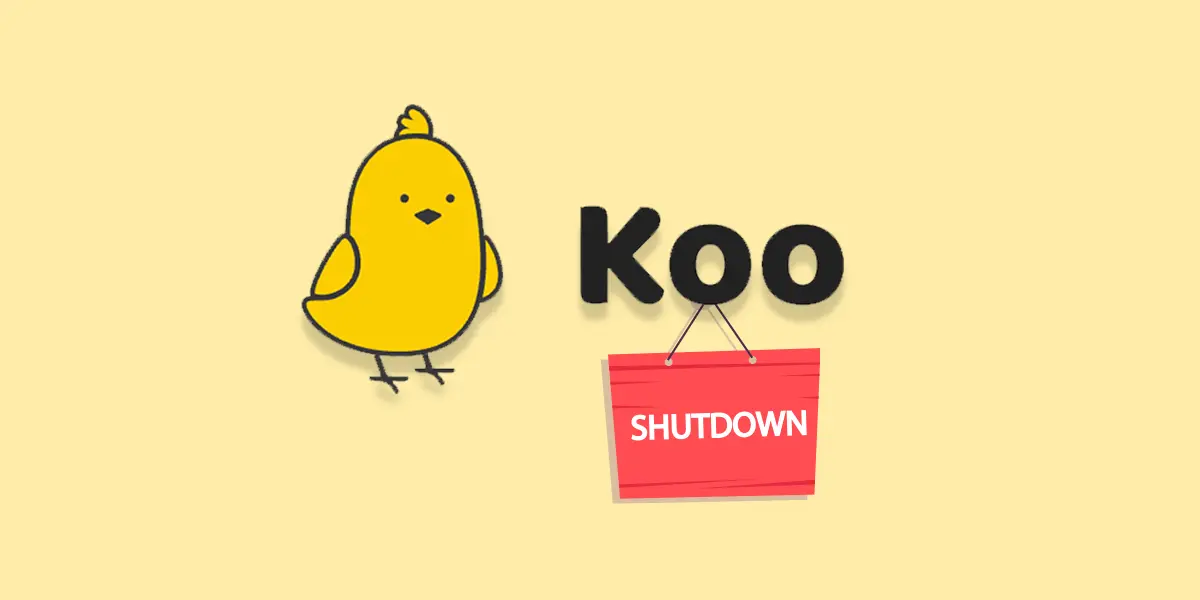Koo app shuts down after merger talks fail.
The failed merger talks were seen as a potential lifeline for Koo, which aimed to combine resources and technical expertise with a larger entity to enhance its presence and financial stability in the market. However the discussions ended on some unspecified issues, and Koo could not get the support it needed to move ahead independently as originally planned.
The shutdown has disappointed many users who had supported the Koo app for building regional languages and regionalizing the social media platform. The shutdown also highlights the ruthlessness of the social networking environment, where even culturally relevant and diverse apps can fail in the face of partnerships and adequate capital.
Koo’s founders Aprameya Radhakrishna and Mayank Bidawatka thanked users and stakeholders for their positive support and highlighted the app’s achievements and milestones during a short period. They also hinted at exploring other avenues in the tech industry, suggesting that even though Koo is shutting down, the team’s entrepreneurial spirit has not diminished.

The recent announcement of Koo shutting down has come as a surprise to many. especially considering that it was deemed as a micro-blogging platform to Twitter especially in India. Thus, the factors explaining the Koo shutdown are diverse and consist of problems in the company’s financial sustainability, pressure from competitors, managerial mistakes in business strategies, and other factors that may impede the successful development of a social media platform.
Financial Struggles
One of the primary reasons for Koo’s shutdown is its financial struggles. Even after closing rounds of funding from reputed investors such as Tiger Global and Accel Partners, Koo could not find operational profitability. The expenses of running an SM platform include, but are not limited to technology and infrastructural support, server and content management, and customer acquisition. the platform struggled to generate consistent revenue streams to offset these expenses.
Competitive Pressures
The market is rather saturated with such key players as Twitter, Facebook, and Instagram taking up most of the market. These web-based applications have large audiences, robust and modern technologies, and significant financial capital. Even though it had a competitive edge of Koo being an app that supports multiple Indian languages, the company could not survive the giants. This level of competition kept adjusting users, particularly those who were already at the deep end of other networks, out of Koo’s grasp.
Failed Merger Negotiations
Koo had been in negotiation on mergers to pool and strengthen its position in the market. Such negotiations will help Koo find the means of survival and development through financial support and technological experience. Yet, the merger plans failed to materialize because of simmering differences that were not made public, thus denying Koo the strategic partner it desired. This proved to be a crucial loss as it ensured that organizational sustenance was not well defined in the firm.
Strategic Missteps
Strategically, Koo may have made some managerial mistakes that led to its downfall. The focus on regional languages was a differentiating factor, but it limited the platform’s appeal to a wider, more diverse user base. Additionally, Koo’s rapid expansion in the face of regulatory scrutiny and political tensions in India may have diverted resources from critical areas such as technology development and user engagement. These strategic decisions, while well-intentioned, may have hindered the platform’s ability to achieve long-term stability.
Challenges in Content Moderation
Censorship is one of the biggest problems faced by any social media application and this became evident when Koo came under attack. The platform faced issues related to the spread of misinformation, hate speech, and other harmful content. Balancing free speech with responsible content management is a delicate task. Koo’s efforts in this regard were questionable. Failure to resolve such problems could potentially cause a setback to users’ satisfaction and their trust in the platform, thereby affecting the platform’s growth plans.
Regulatory Environment
The legal structure in India has been progressively more restrictive relative to social media platforms. Meeting the demands of new regulations, data privacy laws, and government directives requires substantial resources and sophisticated technological solutions. For a relatively new and smaller player Regulatory compliance was especially difficult when the company lacked the same influence and impact as its larger competitors.
Market Saturation and User Acquisition
The social media market is saturated, with users having a wide array of platforms to choose from. Koo as a microblogging platform was that despite having a USP focused on supporting multiple Indian languages, as a feature it was not powerful enough to lure users from other social media platforms. Also, due to changing trends in the use of social media platforms, they have to be constantly updated to meet user demands, a process that involves a lot of capital expenditure on research and development.
How many people use Koo?
By the time of its usage, Koo had almost reached the number of 10 million downloads. The platform saw a huge increase in users in the year 2021 when it was marketed as an Indian clone of Twitter after the Indian government had tensions with the Twitter administration. Once again the support from the Indian Government, the Indian celebrities, and the general public helped in gaining the maximum number of users in a short span.
Koo’s appeal was driven by its unique proposition of supporting multiple Indian languages, catering to a diverse linguistic audience. This feature resonated with users who preferred engaging in their native languages, contributing to its growing user base. The platform also saw a significant influx of users during periods when Twitter faced scrutiny and regulatory challenges in India.
However, Koo still faced the issues of active users’ engagement and, particularly, their retention as it was evidenced by the above numbers. While several mobile users made the installation, consistently using the app was challenging given the stiff competition that the ‘newcomer’ had to deal with, in a social media market perceived to be controlled by big players like Twitter, Face book and Instagram.
Conclusion
The closure of Koo reflects the grim reality of the social media industry. Despite its driving force and initial success, the platform could not cope with the financial, competitive, and regulatory challenges. The failed merger negotiations were the main turning point, as a result of which, Koo lost the financial support it needed in core operations. The closure of the platform not only brings regret to users and founders but also becomes a sign of the lesson that the digital world is indicative of constant transformation. The Koo case study provides a good example of the importance of strategic planning, financial stability, and the ability to adapt to the rapidly changing environment in the social media world.



